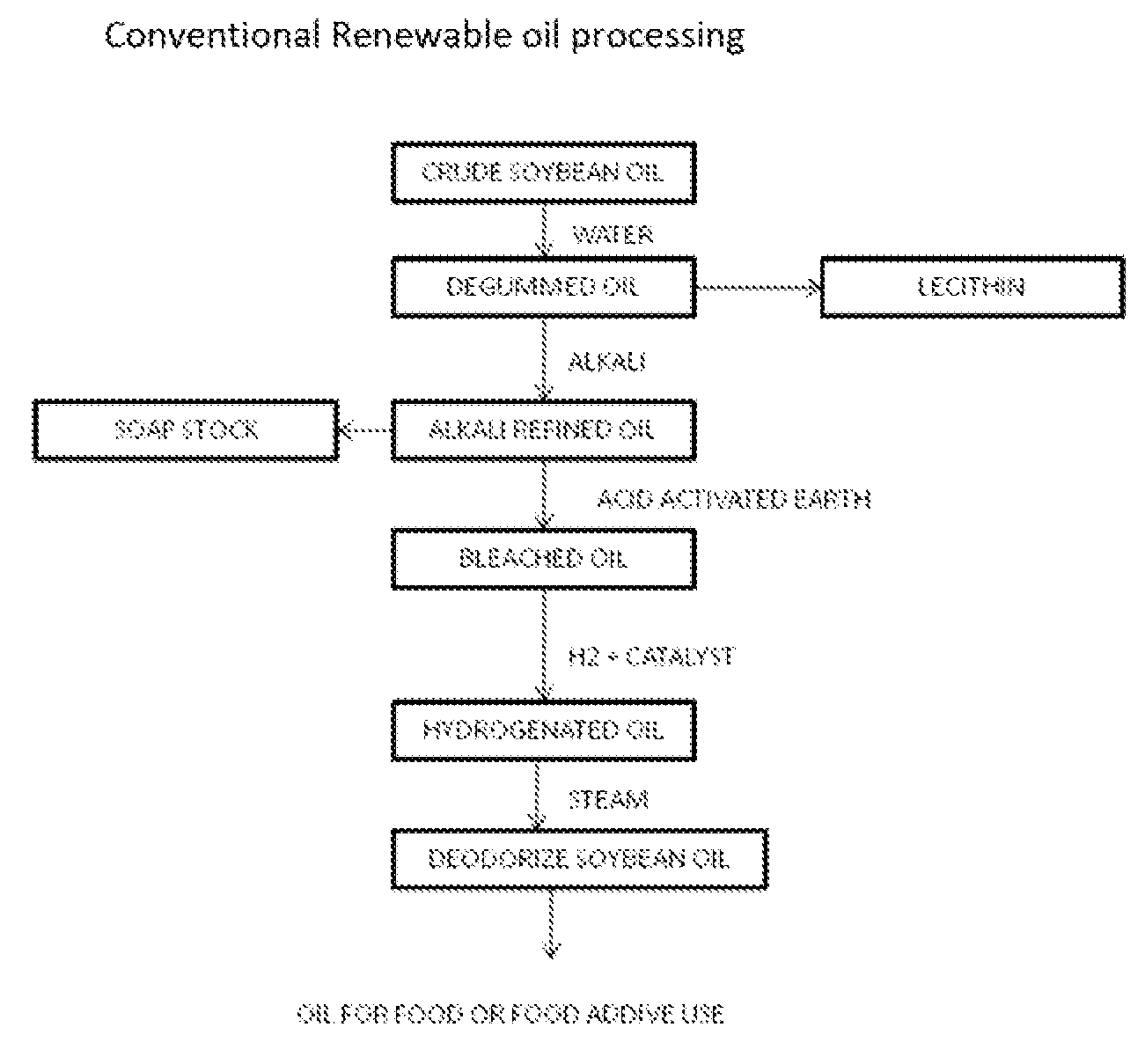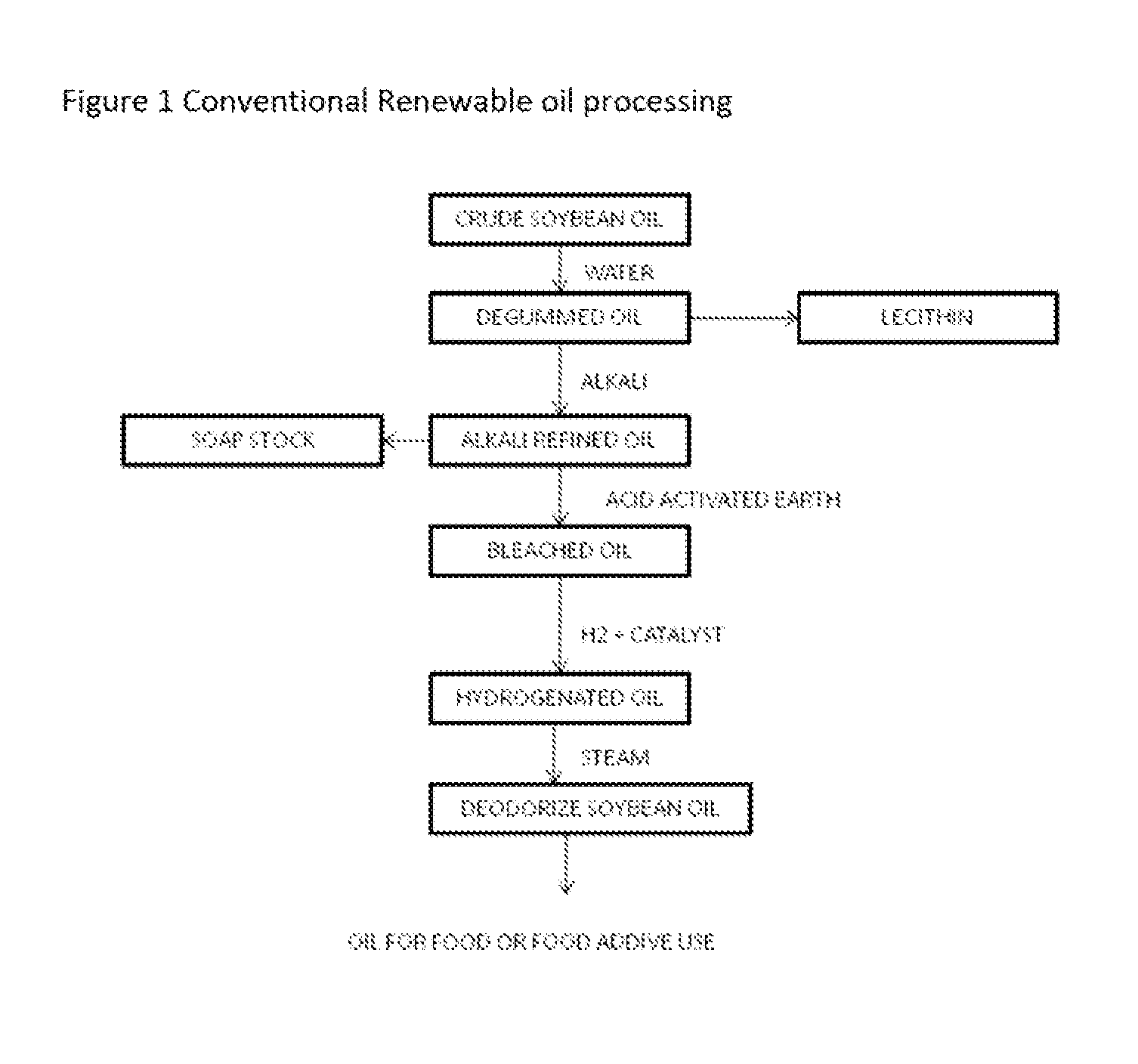Process for upgrading low value renewable oils
a renewable oil and process technology, applied in the direction of liquid gas reaction process, fatty oil/fat refining, inks, etc., can solve the problems of low cost of renewable oil processing and usable commodities, and achieve the effect of greater commercial valu
- Summary
- Abstract
- Description
- Claims
- Application Information
AI Technical Summary
Benefits of technology
Problems solved by technology
Method used
Image
Examples
example 1
Effects of Hydrogenated Oils on Water Resistance of Cellulosic Products
[0168]Cellulosic products, such as paper, cardboard, linerboard, corrugated cardboard, oriented strand board, kraft paper and the like, are generally not water-resistant. Depending upon the ultimate use of the cellulosic product, they may be treated with one or more agents to make them water resistant. This is particularly true for paper products used for manufacturing cartons which will contain food items, such as fresh meat or vegetables, that are shipped in wet ice. Addition of a wax, such as a hydrogenated oil, can increase the water resistance of such products, and make the cartons easier to handle during shipping. Depending upon the construction of the paper product, such as whether it is corrugated or non-corrugated, and its ultimate use, one or more of a variety of different processes may be utilized to coat the paper product with a hydrogenated oil, wax, or comparable agent. The processes for coating the...
example 1a
Effect on Linerboard
[0169]For the purpose of illustrating the invention, one inch by three inch strips of brown corrugated box board with no wax coating may be prepared. The hydrogenated oil may be dispensed into a beaker, and the temperature of the hydrogenated oil maintained at a temperature where the hydrogenated oil remained liquid, for example, 125 degrees C. The corrugated strips may then be dipped into the molten wax for a period of approximately two seconds. Samples may be prepared, and then dipped into the same wax for a second time and allowed to pick up additional wax. After cooling to let the wax solidify on the box board, these samples may be studied for their water resistance, and their ability to be recycled. To test for water resistance, the treated samples may be allowed to sit in room temperature water overnight, and the amount of water taken up by the sample then determined visually. To test for recyclability, the treated samples may be immersed in an alkaline wat...
example 1b
Effects of Hydrogenated Oils on Linerboard: Water Resistance and Recyclability
[0170]To further evaluate the hydrogenated oils they can be compared against a commercially available coating wax, such as one supplied by Citgo Petroleum, Lake Charles, La. (Citgo BLEND-KOTE® 467, Registered trademark of Citgo Petroleum Corp. Houston, Tex.)
Coating Procedure
[0171]Coatings may be made using a wet film applicator (Bird type) with a 1.5 to 5 mil gap depending on viscosity. The coating (the hydrogenated oil prepared in accordance with the present invention), the 4 inch wide applicator and sheets of ½ inch thick plate glass may be placed into a 200 to 250 degrees F. oven for 10-15 minutes, The glass may then be removed from the oven and strips of the linerboard (unbleached kraft paper, as known to those skilled in the art) may be placed onto the glass. A volume of the specific coating (hydrogenated oil) may be placed at one end of the linerboard, the applicator applied to the linerboard and the...
PUM
| Property | Measurement | Unit |
|---|---|---|
| Length | aaaaa | aaaaa |
| Fraction | aaaaa | aaaaa |
| Fraction | aaaaa | aaaaa |
Abstract
Description
Claims
Application Information
 Login to View More
Login to View More - R&D
- Intellectual Property
- Life Sciences
- Materials
- Tech Scout
- Unparalleled Data Quality
- Higher Quality Content
- 60% Fewer Hallucinations
Browse by: Latest US Patents, China's latest patents, Technical Efficacy Thesaurus, Application Domain, Technology Topic, Popular Technical Reports.
© 2025 PatSnap. All rights reserved.Legal|Privacy policy|Modern Slavery Act Transparency Statement|Sitemap|About US| Contact US: help@patsnap.com



